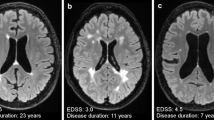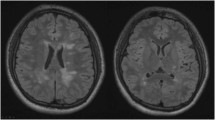Abstract
The widespread use of magnetic resonance imaging (MRI) has led to increased detection of individuals exhibiting asymptomatic brain and spinal cord lesions suggestive of multiple sclerosis (MS), defined as “radiologically isolated syndrome” (RIS). Specific criteria have been proposed and updated over time to identify individuals with RIS. Moreover, a younger age, the presence of infratentorial, spinal cord or gadolinium-enhancing lesions, as well as of cerebrospinal fluid-specific oligoclonal bands have been recognized as relevant risk factors for the occurrence of a first clinical event. Recent randomized controlled trials conducted in individuals with RIS have shown that dimethyl fumarate and teriflunomide significantly reduce the occurrence of clinical events in this population. These findings support the notion that early treatment initiation may positively influence the prognosis of these patients. However, several aspects should be taken into account before treating individuals with RIS in the real-world clinical setting, including an accurate identification of individuals with RIS to avoid misdiagnosis, a precise stratification of their risk of experiencing a first clinical event and further data supporting favorable balance between benefits and risks, even in the long term. This commentary provides an overview of the latest updates in RIS diagnosis, prognosis, and emerging treatment evidence.

Similar content being viewed by others
Data availability
Not applicable.
References
Sunny DE, Amoo M, Al Breiki M, Teng EDW, Henry J, Javadpour M (2022) Prevalence of incidental intracranial findings on magnetic resonance imaging: a systematic review and meta-analysis. Acta Neurochir (Wien) 164(10):2751–2765. https://doi.org/10.1007/s00701-022-05225-7
Morris Z, Whiteley WN, Longstreth WT Jr, Weber F, Lee YC, Tsushima Y et al (2009) Incidental findings on brain magnetic resonance imaging: systematic review and meta-analysis. BMJ 339:b3016. https://doi.org/10.1136/bmj.b3016
De Stefano N, Giorgio A, Tintore M, Pia Amato M, Kappos L, Palace J et al (2018) Radiologically isolated syndrome or subclinical multiple sclerosis: MAGNIMS consensus recommendations. Mult Scler 24(2):214–221. https://doi.org/10.1177/1352458517717808
Lebrun-Frenay C, Kantarci O, Siva A, Azevedo CJ, Makhani N, Pelletier D et al (2023) Radiologically isolated syndrome. Lancet Neurol 22(11):1075–1086. https://doi.org/10.1016/S1474-4422(23)00281-8
Okuda DT, Mowry EM, Beheshtian A, Waubant E, Baranzini SE, Goodin DS et al (2009) Incidental MRI anomalies suggestive of multiple sclerosis: the radiologically isolated syndrome. Neurology 72(9):800–805. https://doi.org/10.1212/01.wnl.0000335764.14513.1a
Thompson AJ, Banwell BL, Barkhof F, Carroll WM, Coetzee T, Comi G et al (2018) Diagnosis of multiple sclerosis: 2017 revisions of the McDonald criteria. Lancet Neurol 17(2):162–173. https://doi.org/10.1016/S1474-4422(17)30470-2
Engell T (1989) A clinical patho-anatomical study of clinically silent multiple sclerosis. Acta Neurol Scand 79(5):428–430. https://doi.org/10.1111/j.1600-0404.1989.tb03811.x
Gilbert JJ, Sadler M (1983) Unsuspected multiple sclerosis. Arch Neurol 40(9):533–536. https://doi.org/10.1001/archneur.1983.04050080033003
Phadke JG, Best PV (1983) Atypical and clinically silent multiple sclerosis: a report of 12 cases discovered unexpectedly at necropsy. J Neurol Neurosurg Psychiatry 46(5):414–420. https://doi.org/10.1136/jnnp.46.5.414
Yamout B, Al KM (2017) Radiologically isolated syndrome and multiple sclerosis. Mult Scler Relat Disord 17:234–237. https://doi.org/10.1016/j.msard.2017.08.016
Forslin Y, Granberg T, Jumah AA, Shams S, Aspelin P, Kristoffersen-Wiberg M et al (2016) Incidence of radiologically isolated syndrome: a population-based study. AJNR Am J Neuroradiol 37(6):1017–1022. https://doi.org/10.3174/ajnr.A4660
Barkhof F, Filippi M, Miller DH, Scheltens P, Campi A, Polman CH et al (1997) Comparison of MRI criteria at first presentation to predict conversion to clinically definite multiple sclerosis. Brain 120(Pt 11):2059–2069. https://doi.org/10.1093/brain/120.11.2059
Wattjes MP, Ciccarelli O, Reich DS, Banwell B, de Stefano N, Enzinger C et al (2021) 2021 MAGNIMS-CMSC-NAIMS consensus recommendations on the use of MRI in patients with multiple sclerosis. Lancet Neurol 20(8):653–670. https://doi.org/10.1016/S1474-4422(21)00095-8
Lebrun-Frenay C, Okuda DT, Siva A, Landes-Chateau C, Azevedo CJ, Mondot L et al (2023) The radiologically isolated syndrome: revised diagnostic criteria. Brain 146(8):3431–3443. https://doi.org/10.1093/brain/awad073
Lebrun-Frenay C, Kantarci O, Siva A, Sormani MP, Pelletier D, Okuda DT et al (2020) Radiologically isolated syndrome: 10-year risk estimate of a clinical event. Ann Neurol 88(2):407–417. https://doi.org/10.1002/ana.25799
Lebrun-Frenay C, Rollot F, Mondot L, Zephir H, Louapre C, Le Page E et al (2021) Risk factors and time to clinical symptoms of multiple sclerosis among patients with radiologically isolated syndrome. JAMA Netw Open 4(10):e2128271. https://doi.org/10.1001/jamanetworkopen.2021.28271
Matute-Blanch C, Villar LM, Alvarez-Cermeno JC, Rejdak K, Evdoshenko E, Makshakov G et al (2018) Neurofilament light chain and oligoclonal bands are prognostic biomarkers in radiologically isolated syndrome. Brain 141(4):1085–1093. https://doi.org/10.1093/brain/awy021
Okuda DT, Mowry EM, Cree BA, Crabtree EC, Goodin DS, Waubant E et al (2011) Asymptomatic spinal cord lesions predict disease progression in radiologically isolated syndrome. Neurology 76(8):686–692. https://doi.org/10.1212/WNL.0b013e31820d8b1d
Okuda DT, Siva A, Kantarci O, Inglese M, Katz I, Tutuncu M et al (2014) Radiologically isolated syndrome: 5-year risk for an initial clinical event. PLoS ONE 9(3):e90509. https://doi.org/10.1371/journal.pone.0090509
Kantarci OH, Lebrun C, Siva A, Keegan MB, Azevedo CJ, Inglese M et al (2016) Primary progressive multiple sclerosis evolving from radiologically isolated syndrome. Ann Neurol 79(2):288–294. https://doi.org/10.1002/ana.24564
Lebrun-Frenay C, Siva A, Sormani MP, Landes-Chateau C, Mondot L, Bovis F et al (2023) Teriflunomide and time to clinical multiple sclerosis in patients with radiologically isolated syndrome: the TERIS randomized clinical trial. JAMA Neurol 80(10):1080–1088. https://doi.org/10.1001/jamaneurol.2023.2815
Okuda DT, Kantarci O, Lebrun-Frenay C, Sormani MP, Azevedo CJ, Bovis F et al (2023) Dimethyl fumarate delays multiple sclerosis in radiologically isolated syndrome. Ann Neurol 93(3):604–614. https://doi.org/10.1002/ana.26555
Filippi M, Amato MP, Centonze D, Gallo P, Gasperini C, Inglese M et al (2022) Early use of high-efficacy disease-modifying therapies makes the difference in people with multiple sclerosis: an expert opinion. J Neurol 269(10):5382–5394. https://doi.org/10.1007/s00415-022-11193-w
Longbrake EE, Hua LH, Mowry EM, Gauthier SA, Alvarez E, Cross AH et al (2022) The CELLO trial: protocol of a planned phase 4 study to assess the efficacy of Ocrelizumab in patients with radiologically isolated syndrome. Mult Scler Relat Disord 68:104143. https://doi.org/10.1016/j.msard.2022.104143
Baker D, Pryce G, James LK, Marta M, Schmierer K (2020) The ocrelizumab phase II extension trial suggests the potential to improve the risk: Benefit balance in multiple sclerosis. Mult Scler Relat Disord 44:102279. https://doi.org/10.1016/j.msard.2020.102279
George IC, Rice DR, Chibnik LB, Mateen FJ (2021) Radiologically isolated syndrome: a single-center, retrospective cohort study. Mult Scler Relat Disord 55:103183. https://doi.org/10.1016/j.msard.2021.103183
Suthiphosuwan S, Sati P, Guenette M, Montalban X, Reich DS, Bharatha A et al (2019) The central vein sign in radiologically isolated syndrome. AJNR Am J Neuroradiol 40(5):776–783. https://doi.org/10.3174/ajnr.A6045
Oh J, Suthiphosuwan S, Sati P, Absinta M, Dewey B, Guenette M et al (2021) Cognitive impairment, the central vein sign, and paramagnetic rim lesions in RIS. Mult Scler 27(14):2199–2208. https://doi.org/10.1177/13524585211002097
Landes-Chateau C, Levraut M, Okuda DT, Themelin A, Cohen M, Kantarci OH et al (2024) The diagnostic value of the central vein sign in radiologically isolated syndrome. Ann Clin Transl Neurol. https://doi.org/10.1002/acn3.51986
Giorgio A, Stromillo ML, Rossi F, Battaglini M, Hakiki B, Portaccio E et al (2011) Cortical lesions in radiologically isolated syndrome. Neurology 77(21):1896–1899. https://doi.org/10.1212/WNL.0b013e318238ee9b
Suthiphosuwan S, Sati P, Absinta M, Guenette M, Reich DS, Bharatha A et al (2020) Paramagnetic rim sign in radiologically isolated syndrome. JAMA Neurol 77(5):653–655. https://doi.org/10.1001/jamaneurol.2020.0124
Bonzano L, Bove M, Sormani MP, Stromillo ML, Giorgio A, Amato MP et al (2019) Subclinical motor impairment assessed with an engineered glove correlates with magnetic resonance imaging tissue damage in radiologically isolated syndrome. Eur J Neurol 26(1):162–167. https://doi.org/10.1111/ene.13789
Amato MP, Hakiki B, Goretti B, Rossi F, Stromillo ML, Giorgio A et al (2012) Association of MRI metrics and cognitive impairment in radiologically isolated syndromes. Neurology 78(5):309–314. https://doi.org/10.1212/WNL.0b013e31824528c9
Filippi M, Preziosa P, Barkhof F, Chard DT, De Stefano N, Fox RJ et al (2021) Diagnosis of progressive multiple sclerosis from the imaging perspective: a review. JAMA Neurol 78(3):351–364. https://doi.org/10.1001/jamaneurol.2020.4689
Rotstein D, Montalban X (2019) Reaching an evidence-based prognosis for personalized treatment of multiple sclerosis. Nat Rev Neurol 15(5):287–300. https://doi.org/10.1038/s41582-019-0170-8
Lassmann H (2018) Multiple sclerosis pathology. Cold Spring Harb Perspect Med. https://doi.org/10.1101/cshperspect.a028936
Correale J, Gaitan MI, Ysrraelit MC, Fiol MP (2017) Progressive multiple sclerosis: from pathogenic mechanisms to treatment. Brain 140(3):527–546. https://doi.org/10.1093/brain/aww258
Filippi M, Preziosa P, Langdon D, Lassmann H, Paul F, Rovira A et al (2020) Identifying progression in multiple sclerosis: new perspectives. Ann Neurol 88(3):438–452. https://doi.org/10.1002/ana.25808
Krieger SC, Cook K, De Nino S, Fletcher M (2016) The topographical model of multiple sclerosis: a dynamic visualization of disease course. Neurol Neuroimmunol Neuroinflamm 3(5):e279. https://doi.org/10.1212/NXI.0000000000000279
Comi G, Martinelli V, Rodegher M, Moiola L, Bajenaru O, Carra A et al (2009) Effect of glatiramer acetate on conversion to clinically definite multiple sclerosis in patients with clinically isolated syndrome (PreCISe study): a randomised, double-blind, placebo-controlled trial. Lancet 374(9700):1503–1511. https://doi.org/10.1016/S0140-6736(09)61259-9
Miller AE, Wolinsky JS, Kappos L, Comi G, Freedman MS, Olsson TP et al (2014) Oral teriflunomide for patients with a first clinical episode suggestive of multiple sclerosis (TOPIC): a randomised, double-blind, placebo-controlled, phase 3 trial. Lancet Neurol 13(10):977–986. https://doi.org/10.1016/S1474-4422(14)70191-7
Kappos L, Polman CH, Freedman MS, Edan G, Hartung HP, Miller DH et al (2006) Treatment with interferon beta-1b delays conversion to clinically definite and McDonald MS in patients with clinically isolated syndromes. Neurology 67(7):1242–1249. https://doi.org/10.1212/01.wnl.0000237641.33768.8d
Filippi M, Preziosa P, Banwell BL, Barkhof F, Ciccarelli O, De Stefano N et al (2019) Assessment of lesions on magnetic resonance imaging in multiple sclerosis: practical guidelines. Brain 142(7):1858–1875. https://doi.org/10.1093/brain/awz144
Solomon AJ (2019) Diagnosis, differential diagnosis, and misdiagnosis of multiple sclerosis. Continuum (Minneap Minn) 25(3):611–635. https://doi.org/10.1212/CON.0000000000000728
Solomon AJ, Arrambide G, Brownlee WJ, Flanagan EP, Amato MP, Amezcua L et al (2023) Differential diagnosis of suspected multiple sclerosis: an updated consensus approach. Lancet Neurol 22(8):750–768. https://doi.org/10.1016/S1474-4422(23)00148-5
Rival M, Thouvenot E, Du Trieu de Terdonck L, Laurent-Chabalier S, Demattei C, Uygunoglu U et al (2023) Neurofilament light chain levels are predictive of clinical conversion in radiologically isolated syndrome. Neurol Neuroimmunol Neuroinflamm. https://doi.org/10.1212/NXI.0000000000200044
Lebrun C, Bensa C, Debouverie M, Wiertlevski S, Brassat D, de Seze J et al (2009) Association between clinical conversion to multiple sclerosis in radiologically isolated syndrome and magnetic resonance imaging, cerebrospinal fluid, and visual evoked potential: follow-up of 70 patients. Arch Neurol 66(7):841–846. https://doi.org/10.1001/archneurol.2009.119
Funding
No targeted funding reported.
Author information
Authors and Affiliations
Corresponding author
Ethics declarations
Conflict of interest
Paolo Preziosa received speaker honoraria from Roche, Biogen, Novartis, Merck Serono, Bristol Myers Squibb and Genzyme; he has received research support from Italian Ministry of Health and Fondazione Italiana Sclerosi Multipla. Maria A. Rocca received consulting fees from Biogen, Bristol Myers Squibb, Eli Lilly, Janssen, Roche; and speaker honoraria from AstraZaneca, Biogen, Bristol Myers Squibb, Bromatech, Celgene, Genzyme, Horizon Therapeutics Italy, Merck Serono SpA, Novartis, Roche, Sanofi and Teva. She receives research support from the MS Society of Canada, the Italian Ministry of Health, the Italian Ministry of University and Research, and Fondazione Italiana Sclerosi Multipla. She is Associate Editor for Multiple Sclerosis and Related Disorders. Massimo Filippi is Editor-in-Chief of the Journal of Neurology, Associate Editor of Human Brain Mapping, Neurological Sciences, and Radiology; received compensation for consulting services from Alexion, Almirall, Biogen, Merck, Novartis, Roche, Sanofi; speaking activities from Bayer, Biogen, Celgene, Chiesi Italia SpA, Eli Lilly, Genzyme, Janssen, Merck-Serono, Neopharmed Gentili, Novartis, Novo Nordisk, Roche, Sanofi, Takeda, and TEVA; participation in Advisory Boards for Alexion, Biogen, Bristol-Myers Squibb, Merck, Novartis, Roche, Sanofi, Sanofi-Aventis, Sanofi-Genzyme, Takeda; scientific direction of educational events for Biogen, Merck, Roche, Celgene, Bristol-Myers Squibb, Lilly, Novartis, Sanofi-Genzyme; he receives research support from Biogen Idec, Merck-Serono, Novartis, Roche, the Italian Ministry of Health, the Italian Ministry of University and Research, and Fondazione Italiana Sclerosi Multipla.
Ethical standards
Not applicable.
Rights and permissions
Springer Nature or its licensor (e.g. a society or other partner) holds exclusive rights to this article under a publishing agreement with the author(s) or other rightsholder(s); author self-archiving of the accepted manuscript version of this article is solely governed by the terms of such publishing agreement and applicable law.
About this article
Cite this article
Preziosa, P., Rocca, M.A. & Filippi, M. Radiologically isolated syndromes: to treat or not to treat?. J Neurol 271, 2370–2378 (2024). https://doi.org/10.1007/s00415-024-12294-4
Received:
Revised:
Accepted:
Published:
Issue Date:
DOI: https://doi.org/10.1007/s00415-024-12294-4




